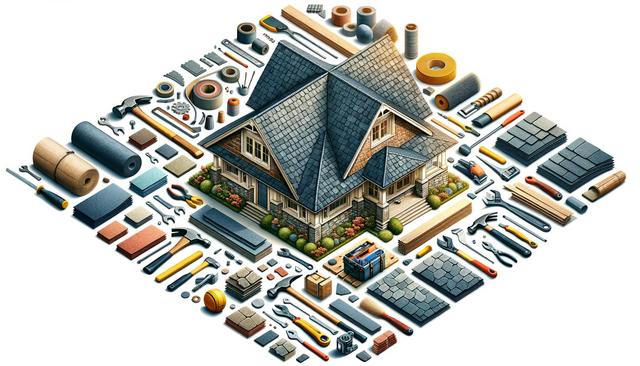Understanding the True Cost of a New Roof
When budgeting for a roof replacement or considering roofing re-roofing options, many homeowners focus only on the visible cost of materials and labor. However, the total cost of a new roof includes more than just shingles or tiles. There are often hidden roofing costs most homeowners miss, such as structural repairs, disposal fees, permits, and unexpected weather delays. It’s also important to factor in potential upgrades like insulation improvements or energy-efficient roofing options, which can increase the upfront investment but lead to long-term energy savings. Understanding what goes into a full quote helps avoid surprises and ensures your project stays on track financially.
Here’s a list of common hidden expenses to be aware of:
- Structural damage repair (e.g., rotted decking)
- Permit and inspection fees
- Removal and disposal of old roofing materials
- Plywood or underlayment replacement
- Upgrades to meet current building codes
By asking your contractor for a detailed breakdown of costs, you’ll have a clearer view of your total investment and can make better choices about where to spend or save.
Types of Roofing Materials and Their Lifespan
Choosing the right roofing material is a key decision. With options ranging from asphalt shingles and metal to tile, wood, and synthetic materials, each has pros and cons in terms of durability, appearance, and price. Knowing how long does a roof last based on the material helps you compare value over time. For example, asphalt shingles typically last 15–30 years, while metal roofs can last 40–70 years depending on the quality. When comparing roof replacement vs repair, the material type can often impact whether a full replacement is necessary or if repairs are sufficient.
Here are a few types of roofing materials and their general lifespan:
- Asphalt shingles: 15–30 years
- Metal roofing: 40–70 years
- Clay or concrete tile: 50+ years
- Wood shakes: 20–40 years
- Synthetic roofing: 30–50 years
When selecting the best roofing material for your home, consider local weather conditions, energy efficiency, and maintenance needs. Energy-efficient roofing options, such as cool roofs or solar-reflective materials, can help reduce cooling costs especially in warmer climates.
Common Mistakes to Avoid in Roofing Projects
Roofing projects come with many variables, and simple missteps can lead to long-term issues. One of the most common mistakes is delaying necessary repairs, which can lead to more extensive damage and higher costs. Recognizing signs you need a new roof early—like missing shingles, leaks, or sagging areas—can help you act before the problem worsens.
Other frequent mistakes include:
- Choosing based on price alone rather than quality and durability
- Overlooking the importance of ventilation and insulation
- Failing to get a proper roofing warranty
- Not checking local building codes and permit requirements
- Hiring unlicensed or uninsured contractors
Understanding these pitfalls and planning accordingly helps ensure your roofing re-roofing project delivers long-term protection and value.
How to Choose a Roofing Contractor Wisely
A reliable contractor can make or break your roofing experience. Knowing how to choose a roofing contractor is essential to getting quality workmanship and avoiding future headaches. Look for professionals who are licensed, bonded, and insured. Check reviews, verify references, and ensure they offer a clear, written contract detailing the scope of work, materials, timeline, and payment terms. A strong roofing warranty is another sign of a trustworthy contractor—it protects your investment and gives peace of mind.
Here are some tips for selecting the right contractor:
- Ask for proof of license and insurance
- Request multiple written estimates for comparison
- Check online reviews and ratings
- Ask about their experience with your specific roofing material
- Ensure they offer a manufacturer-backed roofing warranty
Taking the time to vet your contractor thoroughly can help you avoid costly mistakes and ensure your project is completed to a high standard.
Making the Right Decision: Repair or Replace?
One of the biggest decisions homeowners face is whether to repair or replace their roof. The choice between roof replacement vs repair depends on the age of your roof, the extent of damage, and the material in use. Small, isolated issues might be resolved with a repair, but if your roof is approaching the end of its life expectancy or has widespread damage, replacement is often the more cost-effective option in the long run.
Consider the following when deciding:
- Age of the current roof based on material
- Frequency and severity of recent issues
- Possibility of underlying structural problems
- Energy efficiency improvements with a new roof
- Availability of matching materials for repairs
If your roof is more than 20 years old and showing signs of wear, replacement may offer better long-term value. However, working closely with a trusted contractor can help you evaluate the condition and make an informed decision based on your home’s specific needs.
Conclusion
Roofing projects are a major investment, but with the right knowledge and preparation, you can make choices that protect your home and your budget. From understanding the cost of a new roof and recognizing signs you need a new roof, to selecting the best roofing material and a qualified contractor, each decision plays a role in the success of your project. Whether you’re considering a simple repair or a full roofing re-roofing job, being informed helps you avoid hidden costs and ensures you choose energy-efficient roofing options and materials that align with your long-term goals. Take the time to plan thoroughly, and your roof will provide lasting protection and value for years to come.




Leave a Reply